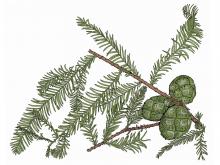Trees, Shrubs and Woody Vines
Media

Species Types
Scientific Name
Nandina domestica
Description
Heavenly bamboo is hardly “heavenly” when it comes to its negative effects on our native plants and animals. A tremendously popular landscaping plant, it readily escapes and is difficult to eradicate.
Media

Species Types
Scientific Name
Sambucus canadensis
Description
Common elderberry is a colony-forming shrub with opposite compound leaves. Its large, flattened clusters of small white flowers produce purple or black berrylike fruits.
Media

Species Types
Scientific Name
Quercus spp.
Description
Oaks are the most important group of trees in Missouri, in both human and ecosystem value. They dominate most of the forests, woodlands, and savannas in the state. Learn more about our 22 species.
Media

Species Types
Scientific Name
Symphoricarpos orbiculatus
Description
Buckbrush, or coralberry, grows throughout Missouri. This familiar thicket-forming shrub bears dense clusters of pinkish-red berries that persist through most of the winter.
Media

Species Types
Scientific Name
Taxodium distichum
Description
Bald cypress is an “evergreen” tree that is not evergreen! Like the leaves of hardwoods, its needles turn yellow in the fall and are shed. A tree associated with swamps, its impressive form also graces many public landscapes.
Media

Species Types
Scientific Name
Quercus nigra
Description
Its range and interesting, variable leaf shapes identify water oak. Like many species that require wet lowland forests, water oak has been declining in our state due to long-term extensive disruption of natural habitats in our Bootheel counties.
Media

Species Types
Scientific Name
Quercus lyrata
Description
Overcup oak is fairly easy to identify. The acorns are almost completely covered by their knobby cups. The leaves have long, narrow lobes and wide sinuses. In Missouri, it grows naturally only in wet forests along the Mississippi and Meramec rivers.
Media

Species Types
Scientific Name
Quercus bicolor
Description
A beautiful tree, swamp white oak features bicolored leaves that are shiny, dark green above and downy white below. When a breeze sets them in motion, their wavy or lobed shapes add a calm grace to a summer's hike.
Media

Species Types
Scientific Name
Quercus falcata
Description
This tree has two names as well as two leaf types! In Missouri, southern red oak, or Spanish oak, occurs natively only in our southeast and southernmost counties.
Media

Species Types
Scientific Name
Quercus alba
Description
Found throughout Missouri and in all kinds of habitats, the white oak is one of our most attractive, long-lived, and stately shade trees. Learn to recognize it by its light gray bark, rounded-lobed leaves, and distinctive acorns.
See Also
About Trees, Shrubs and Woody Vines in Missouri
There are no sharp dividing lines between trees, shrubs, and woody vines, or even between woody and nonwoody plants. “Wood” is a type of tissue made of cellulose and lignin that many plants develop as they mature — whether they are “woody” or not. Trees are woody plants over 13 feet tall with a single trunk. Shrubs are less than 13 feet tall, with multiple stems. Vines require support or else sprawl over the ground.





















